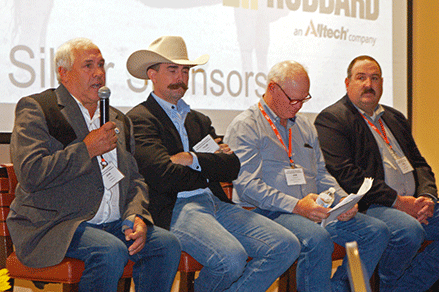
Elite Commercial Cattlemen session
Each panelist — John Moes, Moes Feedlot, Watertown, S.D.; Trey Patterson, Padlock Ranch, Ranchester, Wyo.; Tylor Braden, King Ranch, Kingsville, Texas; and John Maddux, Maddux Cattle Co., Wauneta, Neb. — operates in a vastly different environment.
Strategies for Success
Successful commercial producers with different markets and goals share similar strategies.
by Kasey Brown, associate editor
BROOKINGS, S.D. (June 19, 2019) — Beef operations can be as different as night and day, and that was no exception with the four panelists of the Elite Commercial Cattlemen session at the 2019 Beef Improvement Federation Annual Convention. These cattlemen gathered in Brookings, S.D., June 18-21, and shared surprisingly similar strategies to gain success in their differing operations.
Some major themes included fitting cattle to their environment, having marketing strategies and backup strategies, focusing on fertility, and using technology for improvement.
Environment
While each panelist — John Moes, Moes Feedlot, Watertown, S.D.; Trey Patterson, Padlock Ranch, Ranchester, Wyo.; Tylor Braden, King Ranch, Kingsville, Texas; and John Maddux, Maddux Cattle Co., Wauneta, Neb. — operates in vastly different environments, each emphasized the need for cattle to fit.
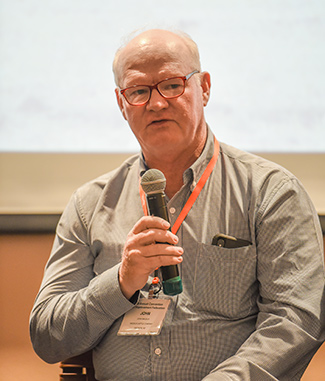
Panelist: John Maddux
“Stocking rate is the key driver to profitability,” said John Maddux, Maddux Cattle Co., Wauneta, Neb., adding that selecting for moderate size and fertility traits are major selection goals.
For Maddux, that means having moderately sized females. His herd consists of five-breed composites and excels in fitness and convenience traits. He admitted his mature cows weigh, on average, 1,110 pounds. They may not wean the biggest calves, but they allow for a higher stocking rate because of their size — thus spreading fixed costs over more animals.
“Stocking rate is the key driver to profitability,” he said, adding that selecting for moderate size and fertility traits are major selection goals. “If you can draw a perfect profit function for a cow, it is heavily driven by her ability to raise a calf.”
Braden deals with the harsh heat, parasites and biosecurity issues of south Texas. He controls this through genetic selection and adjusting his stocking rate accordingly. His heifers serve as stockers. Those that breed early can stay.
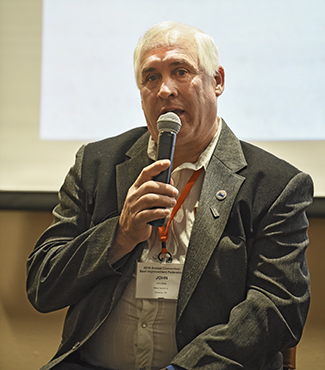
Panelist: John Moes
“If we don’t use the technology available, we’re going to lose it,” said John Moes, Moes Feedlot, Watertown, S.D.
Moes manages his environment by blood-testing his heifers to ensure they haven’t picked up neospora from coyote feces. Neospora can cause embryonic abortion. Only heifers that test negative stay in the herd.
Patterson said Padlock cows and heifers must rough it out on winter range, and often heifers show compensatory gain in the summer. By using heterosis-heavy bulls, Patterson said they are able to concentrate more on range management than specific breeding groups. He also sorts cows bred in the last 21-day cycle of the breeding season into a separate herd, and those are the first culled during drought.
Marketing strategies, fertility
Each cattleman noted their targeted marketing group, but each also had a backup plan. For example, several said heifers that are bred later in the breeding season are sold as bred heifers that fit a different operation’s timeline.
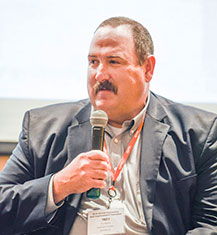
Panelist: Trey Patterson
To hit the markets when they aren’t flooded with supply, Patterson said Padlock Ranch, Ranchester, Wyo., uses farm products to put weight on calves during the winter and then sells them as yearlings.
To hit the markets when they aren’t flooded with supply, Patterson said at Padlock Ranch, they use farm products to put weight on calves during the winter and then sell them as yearlings instead.
Moes said any heifers not bred by artificial insemination (AI), so those bred in the last cycle of the breeding season, go to the feedlot and still gain premiums in niche markets.
Fertility is important to each of the panelists. All emphasized the importance of females being bred early in the breeding season, especially replacement heifers, no matter if by synchronized artificial insemination or bulls.
Technology
Selecting for fertility has gotten easier with the use of technology. Each panelist noted the increasing suite of maternal-focused expected progeny differences (EPDs) — udder, docility, calving ease and structure.
While each used technology to a different extent, from using EPDs for genetic selection to synchronizing the breeding season to DNA testing all females and using own-herd EPDs, they all praised technology as tools.
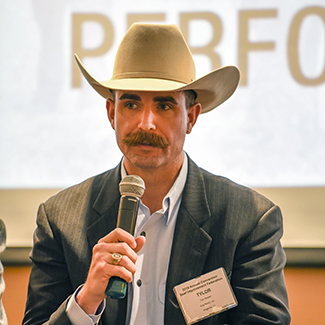
Panelist: Tylor Braden
Tylor Braden, King Ranch, Kingsville, Texas, deals with the harsh heat, parasites and biosecurity issues of south Texas. He controls this through genetic selection and adjusting his stocking rate accordingly.
Technology, especially in terms of genetic progress, allows for more cost control, said Braden. He admitted there are more opportunities to control costs than there are to add value, especially if quality grid value is already high. Genomics allow him to identify the most fertile animals.
Braden likened genetic improvement to losing weight. It is not linear. The first 50% of progress is relatively easy. The next 25% is harder, the following 15% is much harder, and that last 10% of progress you want is nearly impossible. To make that progress, though, the tools need to be available and people need to use them.
Moes added: “If we don’t use the technology available, we’re going to lose it.”
The 2019 BIF Annual Convention was hosted by South Dakota State University and the South Dakota Beef Breeds Council June 18-21 at the University Comfort Suites and Convention Center in Bookings. ANGUS MEDIA® provides comprehensive online coverage of the event at www.BIFconference.com. Visit the Newsroom for summaries, proceedings, PowerPoints, video and/or audio of the sessions and the Awards page for announcements and photos of award winners.
Editor’s Note: This summary was written under contract or by staff of ANGUS MEDIA®. Through an agreement with the Beef Improvement Federation,
we encourage reprinting of the articles to those who will adhere to the
reprint guidelines available on this site. Please review those
guidelines or contact Shauna Rose Hermel,
editor, at 816-383-5270. PowerPoints are posted with permission of the
presenter and may not be reproduced in whole or in part without the
express permission of the presenter. We welcome educational venues and
cattlemen to link to this site as a service to their audience.
For questions about this site, or to notify us of broken links, click here. Look for additional coverage in the Angus Journal, the Angus Beef Bulletin, the Angus Journal Daily, the Angus Beef Bulletin EXTRA and Angus TV.


